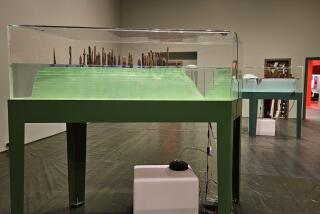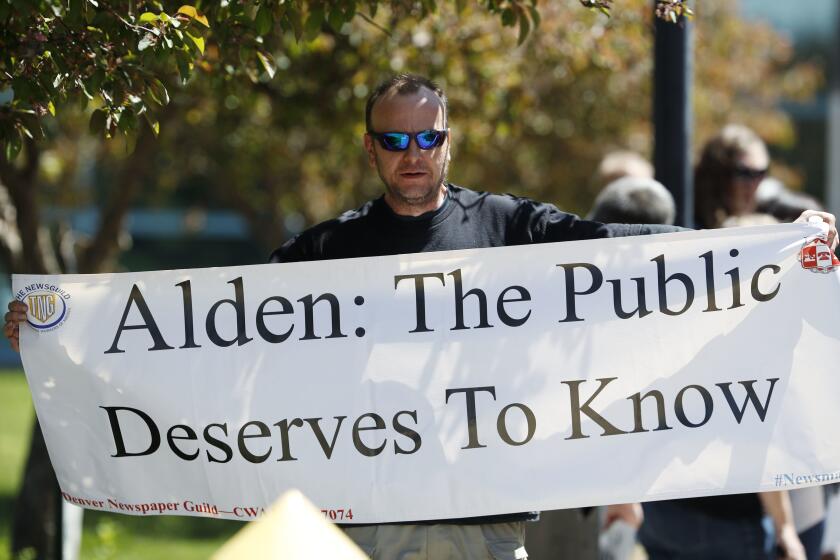Mostly thumbs up: What the critics say about the new Whitney Museum

The Whitney Museum of American Art opens its new building to the public this week. “Boy,” by sculptor Charles Ray, looks on as members of the media get a preview tour of the museum in advance of its opening
The reviews are pouring in — and the state of the museum is strong.
The newly relocated Whitney Museum of American Art in downtown Manhattan appears to be pleasing the critics, with its current permanent collection display “America Is Hard to See,” but also with its new light-filled galleries, river views and vast outdoor sculpture terraces. That is, even if no one can quite get a handle on what the exterior form of architect Renzo Piano’s unusual building is trying to do.
In fact, the architecture has inspired all kinds of colorful descriptions. New York Times critic Holland Cotter describes it as having “the bulk of an oil tanker’s hull.” Peter Schjeldahl, of the New Yorker, describes it as a “lurching aggregate of shapes in striated steel cladding and glass.”
But it’s Howard Halle of Time Out New York who comes in with the best word picture: “a silvery hulk” that “lords over a once-gritty Meatpacking District” that “resembles nothing so much as a nuclear-powered guided-missile cruiser moored at the foot of the High Line.” The building, he adds, “seems poised to shoot Tomahawks at New Jersey.”
Personally, I think that, from certain angles, the building bears an uncanny resemblance to Bender, the robot from Futurama or, perhaps, one of the cylons from the original Battlestar Galactica.
Generally, the critics seem to be far more pleased with the museum’s interior spaces, which appear to accommodate the art quite nicely — even if it’s a bit showy (so many selfie-inducing terraces with Hudson River views!). But as the Whitney prepares to open to the public on Friday, some of the earliest reviews indicate that the museum is a fine one and that its inaugural show is well worth exploring.
Cotter says that being able to see more than 600 works by some 400 artists from the museum’s collection was “as good a reason as any to have made a move.” And he generally praises many of the thematic arrangements, especially the inclusion of a good dose of political and socially engaged art.
“Drawings and prints from the 1930s protesting anti-black violence have immediate relevance,” Cotter writes. “A 1970 film by Howard Lester called ‘One Week in Vietnam,’ which flashes photographs of American soldiers killed in the war in a span of seven days, is still a punch to the gut.”
The New Yorker’s Schjeldahl is also generally positive, praising the different groupings — which cover everything from the foundation of the museum by Gertrude Vanderbilt Whitney to art in post-9/11 America.
“First-rate works stand out for their timeless qualities and easily slip the bonds of their classification, while lesser ones provide grace notes and variations on the dominant themes,” he states. “Seeing, thinking and evaluating proceed in harness. People will revisit and debate the show until it closes, in September.”
Of course, “America Is Hard to See” contains oversights, some of which are due to the nature of the Whitney’s collection — strong in some areas of art (New York) and weaker elsewhere (the rest of the country). Schjeldahl notes this in his review, as do various other critics, who parse the works that go un-shown.
But my colleague Christopher Knight makes the strongest point of it: “The collection’s glaring parochialism will mostly get a pass,” he writes in his review, “unnoticed by tourists and embraced by the locals for its cozy familiarity.”
He notes the absence of pioneering art photographer Edward Weston, as well as a solid representation from entire schools of art: mid-century Bay Area figuration, Southern California Light and Space art and pattern and decoration works, so popular in the 1970s.
But if there is one thread that appears throughout the many reviews it’s that the exhibition offers some fantastic juxtapositions of the familiar alongside the more obscure. In fact, this very trait appears at No. 1 on the list of Brian Boucher’s “10 Reasons to Be Excited About the Whitney Museum.”
Such pairings include a painting by self-taught artist Bill Traylor hanging next to a canvas by the esteemed Marsden Hartley, or a small depiction of a mechanical device by the little-known Morton Schamberg in a room with works by Georgia O’Keeffe and Edward Hopper.
Every critic — including Andrew Russeth at ARTnews, Jillian Steinhauer at Hyperallergic and Paddy Johnson at Art F City — seems to find interesting proximities worth examining. This makes poring over all of the various reviews pretty worthwhile, especially if, like me, you won’t be hitting the new museum anytime soon.
If you want a good primer that goes beyond critique, however, it’s definitely worth reading Jerry Saltz’s epic walk-up in New York magazine, which provides a thorough overview of the Whitney’s history, the history of museums and what the move to the new building represents.
All of it is making me pretty excited to check out the new Whitney the next time I land in New York.
“America Is Hard to See” goes on view at the Whitney Museum of American Art on Friday and runs through Sept. 27, at 99 Gansevoort St., New York, whitney.org.
Find me on Twitter @cmonstah.
More to Read
The biggest entertainment stories
Get our big stories about Hollywood, film, television, music, arts, culture and more right in your inbox as soon as they publish.
You may occasionally receive promotional content from the Los Angeles Times.











